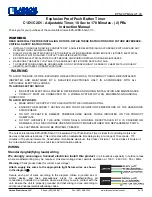
M e r i d i a n I I U s e r M a n u a l
76
C H A P T E R S E V E N
77
M e r i d i a n I I U s e r M a n u a l
N E T W O R K T I M E P R O T O C O L ( N T P )
Mask Alarm
In Stratum 1 operation an alarm will be indicated when there is a loss of signal or if the antenna is
not connected. For Stratum 2 operation you may not want to see these alarms. You can mask them
(prevent them from showing) by using the console port (serial/network) commands
setsigfltmask
and
setantfltmask
. Or, on the front-panel keypad/display go to the Faults submenu. Look for
SigFltMask and AntFltMask and set them appropriately.
Setting Up NTP Clients on
Unix-like Platforms
To configure your Unix-like computer to use your Meridian II, you must have successfully completed
the NTP Server basic installation procedure described above. It is expected that you are, or have
access to, a capable Unix/Linux system administrator and know more than a little about installing
distributions from source code. Installation must be performed by a user with root priviledges on the
system.
If you have access to a usenet news server, many problems may be solved by the helpful people who
participate in the Internet news group devoted to NTP at
comp.protocols.time.ntp
.
Three methods of using Meridian II with NTP clients on Unix-like platforms will be described:
Basic:
This is the simplest, and will operate without MD5 authentication.
NTP beginners should
always perform this setup first
.
MD5:
This method is trickier only because MD5 keys must be set up and distributed accurately to
the NTP clients in a secure way. Meridian II is factory configured to authenticate its replies to NTP
MD5 clients using its default set of keys.
Broadcast/Multicast:
This method simplifies configuration of the clients on large networks since
specific server addresses need not be configured in each client’s
/etc/ntp.conf
file. It can be config-
ured either with or without MD5 authentication. However, it is highly recommended that authentica-
tion be configured when using broadcast/multicast mode due to the relative ease with which a fake
NTP server can take over the clock setting of the broadcast/multicast clients on the network.
Unix-like Platforms: Basic NTP Client Setup
Basic setup is relatively simple, if:
• You have been able to successfully communicate with Meridian II on your network.
• You have installed NTP on your client computer.
Configure NTP
You must edit the
ntp.conf
file which
ntpd
, the NTP daemon, looks for by default in the the
/etc
directory. Add this line to the ntp.conf file:
server 192.168.1.120
Summary of Contents for Meridian II
Page 2: ......
Page 20: ...M e r i d i a n I I U s e r M a n u a l This page intentionally left blank...
Page 139: ...119 M e r i d i a n I I U s e r M a n u a l R E A R P A N E L I O...
Page 216: ...M e r i d i a n I I U s e r M a n u a l 196 A P P E N D I X J...
Page 235: ...215 M e r i d i a n I I U s e r M a n u a l S P E C I F I C AT I O N S...
Page 236: ...M e r i d i a n I I U s e r M a n u a l 216 A P P E N D I X K...
Page 239: ......
















































